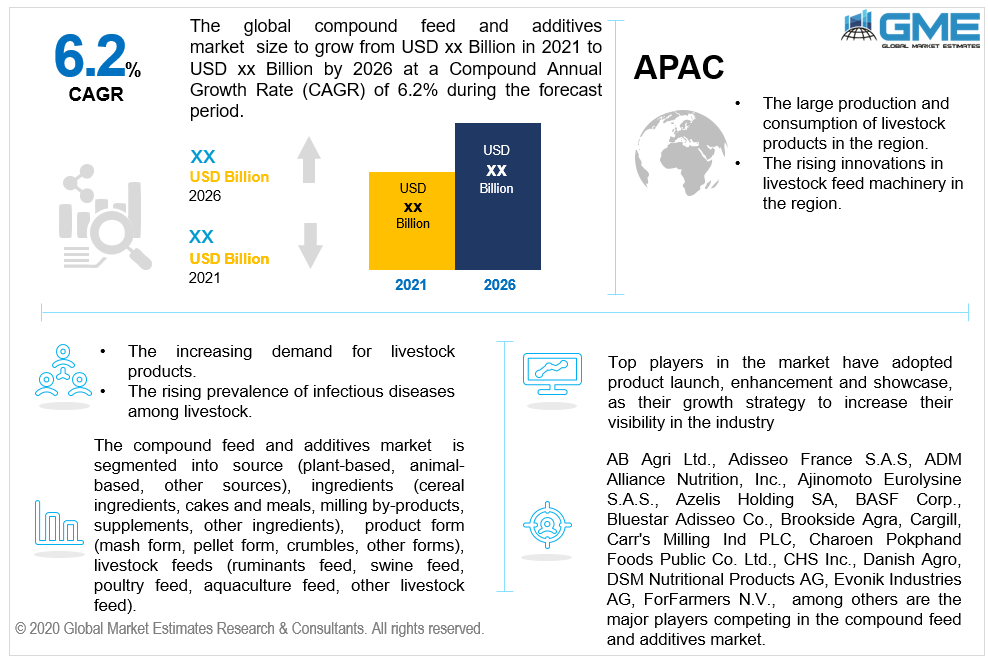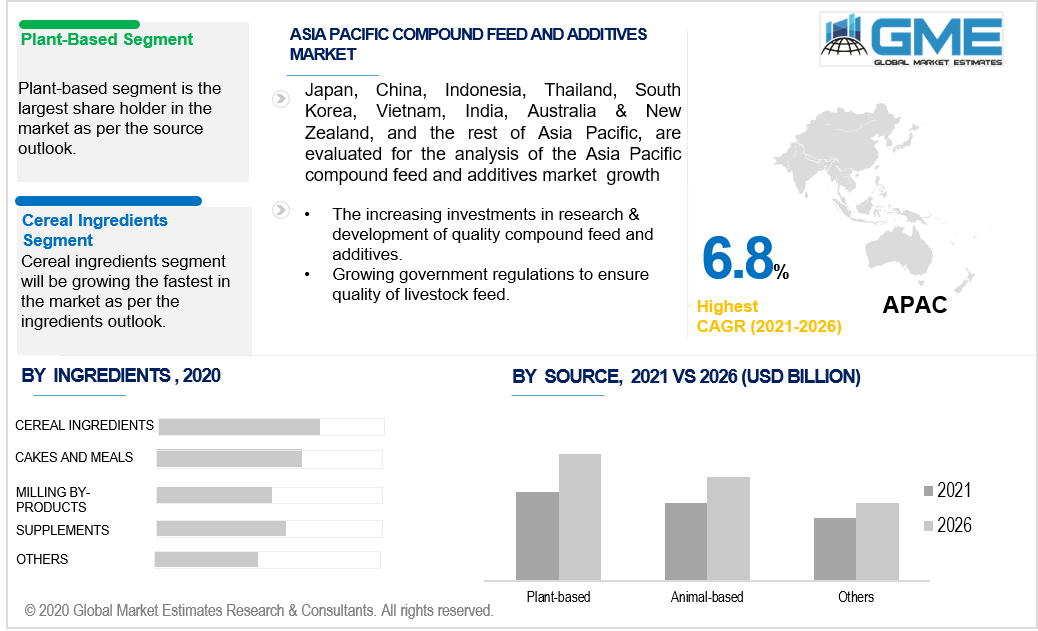
Global Compound Feed and Additives Market Size, Trends, and Analysis - Forecasts To 2026 By Source (Plant-Based, Animal-Based, Other Sources), By Ingredients (Cereal Ingredients, Cakes, and Meals, Milling) By Products (Supplements, Other Ingredients), By Product Form (Mash Form, Pellet Form, Crumbles, Other Forms), By Livestock Feeds (Ruminants Feed, Swine Feed, Poultry Feed, Aquaculture Feed, Other Livestock Feed), By Region (North America, Asia Pacific, CSA, Europe, and the Middle East and Africa); End-User Landscape, Company Market Share Analysis & Competitor Analysis
Compound feeds are feed that is manufactured to supplement the growth of the livestock. The feeds have different nutritional values and mix to support the growth stage of the animal and the specific need of the livestock product in question. Compound feeds are generally sourced from grains, bran, soybeans, sorghum, barley, oats, corn, rice, poultry meal, meat, and bone, among other sources. The main use of compound feed is to provide top-notchnutrients to the livestock. Feed additives are supplements that are added to the livestock feed to enhance the nutritional quality of the existing feed or have medicinal properties to prevent or cure diseases afflicting the livestock. The growing demand for livestock products in the world is the major driver of the compound feed and additives market. The growing demand for quality feed that provides the livestock with the necessary nutrients is on the rise as livestock farmers across the world try to meet the growing demand for livestock. The compound feed and additives market is also driven by the growing demand for quality meat products and the growing stringent government regulations surrounding livestock products. Animal farmers are also becoming increasingly aware of animal health risks and the need for quality compound feed and feed additives to ensure their product is not at risk. There is also a growing awareness among consumers about the need for quality compound feeds and additives and the benefits of consuming livestock products that have been fed good quality feed. The compound feed and additives market is restrained by the growing animal rights movements that aim to reduce consumption of livestock products, the fluctuations in cost and the availability of raw materials required for feed production, and the stringent regulations on livestock product quality and their quality of life especially in countries like the US and in regions like Europe.

Based on source, the compound feed and additives market can be segmented into plant-based, animal-based, and other sources. The plant-based sources segment is the most dominant segment with the highest market sharefrom 2021 to 2026. Commercially available feeds are most commonly made from feed grains like corn, soybeans, oats, barley, and sorghum. Most livestock that is raised commercially is herbivorous and given that the most profitable livestock like poultry and cattle are dependent on plant-based feeds along with the cost-effectiveness of such plant-based feed, the pant-based sources are expected to continue holding the largest share of the among the other segments.
Based on ingredients, the compound feed and additives market can be segmented into cakes and meals, cereal ingredients, supplements,milling by-products, other ingredients. The cereal ingredients segment is the most dominant segment with the highest market share from 2021 to 2026. The most common and vital source or form of energy for this livestockis cereals. Cereals are easier to source for compound feed vendors and can be locally sourced from local farmers. The type of cereal varies from region to region depending on the availability of cereals in the region. Cereals are sources of high energy required by the livestock and are cheaper which has resulted in the dominance of the cereal ingredients segment over other segments.
Based on the product form, the compound feed and additives market can be segmented into crumbles, pellet form, mash form, other forms. The pellet form segment is the most dominant segment with the highest market share from 2021 to 2026. Pellets are easier to store and transport and can be easily measured out to prevent overfeeding or underfeeding of the livestock. Pellets are easier to digest for the animals than other forms of feed, have increased feed density, decrease wastage and selection, and offer better mechanical handling of the feed on automated feed lines. These advantages of the pellet form over other feed forms are expected to increase the demand for pellet form feed in the compound feed and additives market.
The compound feed and additives market can be segmented based on the livestock feed as aquaculture feed, swine feed, ruminants feed, poultry feed, and other livestock feed. The poultry feed segment will dominate the market and also grow the fastest withthe largest CAGR rate among the remaining segments. Poultry products have the hugest demand among all livestock products given the massive consumer preference for poultry products. Poultry is easier to raise, has low life expectancies, and has a smaller growth period among other livestock which increases the volume of poultry products that can be traded by the vendors. A large number of poultry farms and the massive commercial poultry population are the major drivers of the poultry feed segment.

The APAC region will be the largest growing regional segment with the highest market share of all the other regions. China is the largest producer and consumer of compound feeds and other nations in the region like India have largely agrarian economies which have resulted in the dominance of this region. The introduction of modern feed industry processes, feed machinery, feed science, and the quality management of feed are the major drivers for the compound feed and additives market in the region. The EU region will be growing fastest with a higher CAGR value than other regions. The region has seen large investments in the development of novel feed combined with the stringent feed regulations are expected to have a positive impact on the growth of the compound feed and additives market in the region.
BluestarAdisseo Co.,Adisseo France S.A.S,AB Agri Ltd.,BASF Corp.,Ajinomoto Eurolysine S.A.S.,Cargill,Brookside Agra,Charoen Pokphand Foods Public Co. Ltd., Danish Agro,CHS Inc., Azelis Holding SA,DSM Nutritional Products AG, ForFarmers N.V., Evonik Industries AG, General Mills Inc., Kraftfutter-Meyer GmbH & Co. Kilograms, Carr's Milling Ind PLC, and Hill's Pet Nutrition, Inc., among others, are the majorvendors competing in the compound feed and additives market.
Please note: This is not an exhaustive list of companies profiled in the report.
We value your investment and offer free customization with every report to fulfil your exact research needs.
The Global Compound Feed and Additives Market has been studied from the year 2019 till 2026. However, the CAGR provided in the report is from the year 2021 to 2026. The research methodology involved three stages: Desk research, Primary research, and Analysis & Output from the entire research process.

The desk research involved a robust background study which meant referring to paid and unpaid databases to understand the market dynamics; mapping contracts from press releases; identifying the key players in the market, studying their product portfolio, competition level, annual reports/SEC filings & investor presentations; and learning the demand and supply-side analysis for the Compound Feed and Additives Market.

The primary research activity included telephonic conversations with more than 50 tier 1 industry consultants, distributors, and end-use product manufacturers.

Finally, based on the above thorough research process, an in-depth analysis was carried out considering the following aspects: market attractiveness, current & future market trends, market share analysis, SWOT analysis of the company and customer analytics.

Tailor made solutions just for you
80% of our clients seek made-to-order reports. How do you want us to tailor yours?
OUR CLIENTS